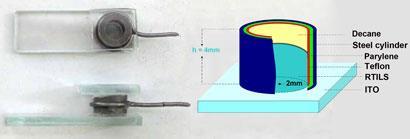Exchanging conductive fluid boosts performance of variable focus lenses
Ionic liquids are the key to observing improved performance and wider temperature ranges for variable focus lenses over conventional saline alternatives, report scientists in China.
Electrowetting-based variable focus liquid lenses (EVFLL) have been used in mobile phones, barcode readers and other optical equipment, in which the conductive liquid inside the lenses is currently limited to saline. In applications such as these, saline can only work in a narrow temperature range as it may evaporate or freeze in extreme temperatures. The lenses also need to operate in a wide spectral range, but again saline is restrictive here as it becomes opaque in the near infrared region - not ideal for optical devices.
Youquan Deng and colleagues from Lanzhou Institute of Chemical Physics and Lanzhou University have reported the first ionic liquid-based EVFLL, in a bid to overcome these problems. The team used a typical EVFLL set up to test nine imidazolium ILs. EVFLL consists of a steel cylinder that is Teflon coated and the IL droplet is injected inside the cylinder, along with dodecane to minimise moisture transfer. Two glass plates are then glued into place (both top and bottom) with UV plastic. Once a voltage is applied to the EVFLL, this changes the wettability of the IL inside, affecting the curvature of the IL meniscus and subsequently creating a variable focus range.

’Owing to the surface tension of ILs, the meniscus interface remains smooth on a nanometre scale and has a self-healing property. As a result, liquid lenses have a highly precise optical surface, equivalent to that obtained in glass lenses after delicate polishing work,’ explains Deng.
The IL-based EVFLL could operate up to 100 degrees Celsius, whilst maintaining its performance and stability. It had faster response times and lower power consumption in comparison to the saline-based alternatives. The device also showed good transmittance in the visible and near infrared regions.
Robin Rogers, an ionic liquid expert from the University of Alabama in the US believes that: ’This is an example in which combining the properties of a pure salt with those of a pure liquid allows for unique applications. Of particular interest are the ranges of refractive indices and electrowetting behaviors that open up a much wider potential focusing range.’
’This IL-based EVFLL has provided a fascinating example of the versatility of ionic liquids compared to traditional salt solutions,’ says John Wilkes, head of the United States Air Force Academy research centre in Colorado. ’The practical implication of the experiments has not escaped our notice.’
Emma Shiells
Interesting? Spread the word using the ’tools’ menu on the left.
Link to journal article
Ionic liquid based variable focus lensesXiaodong Hu, Shiguo Zhang, Chao Qu, Qinghua Zhang, Liujin Lu, Xiangyuan Ma, Xiaoping Zhang and Youquan Deng,?Soft Matter, 2011, 7, 5941DOI:10.1039/c1sm05585b






No comments yet